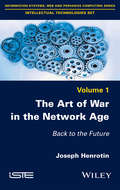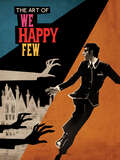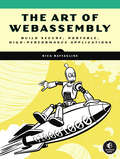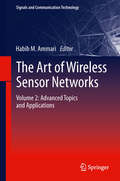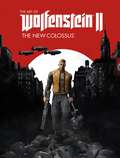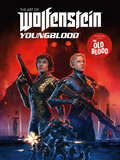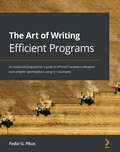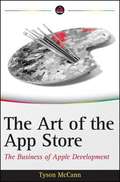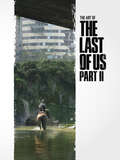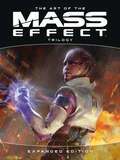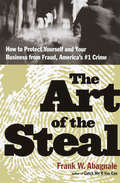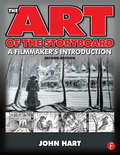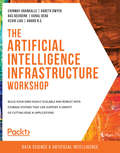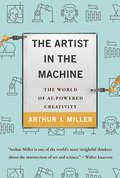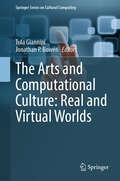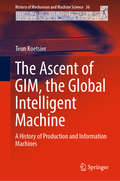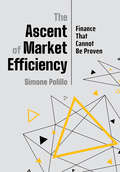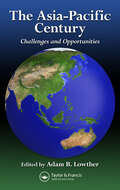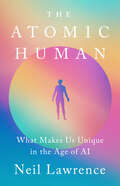- Table View
- List View
The Art of War in the Network Age: Back to the Future
by Joseph HenrotinExamining the influence of information technology on the art of war theoretical structure and, beyond, the concrete effects of those technologies on the conduct of war (thus, not warfare) itself. What could be the influence of information technology on the art of war theoretical structure and, beyond, what are the concrete effects of those technologies on the conduct of war itself? "Art build upon a science", strategy is often forgotten by publications dealing with the impacts of technology on warfare, but are network-centric warfare and all those technological artefacts really a revolution for war? The interaction of theoretical strategy and information networks has not really been systematically treated before this book.
The Art of We Happy Few
by Compulsion GamesThe official art book to the game! Two-hundred pages of mind-bending art and insightful creator commentary exploring the conceptualization and execution of We Happy Few!October, 1964. The City of Wellington Wells is all that's left of England after the German invasion and four years of occupation. But it's still the swinging '60s, and everyone is fab, especially because they're taking happy pills--Joy--and wearing Happy Face masks so they're always smiling . . . everyone except the awful Downers who live in the abandoned Garden District and refuse to take their Joy. Dark Horse Books and Compulsion Games are thrilled to present The Art of We Happy Few. Showcasing a unique retro-futuristic style, this book includes hundreds of pieces of concept art, paired with exclusive commentary from the team that created it! Don't be a Downer by missing out on this perfect companion to the psychedelic videogame experience!
The Art of WebAssembly: Build Secure, Portable, High-Performance Applications
by Rick BattaglineA a thorough, practice-based introduction to WebAssembly. Learn how to create high-performing, lightning-fast websites and applications. WebAssembly is the fast, compact, portable technology that optimizes the performance of resource-intensive web applications and programs. The Art of WebAssembly is designed to give web developers a solid understanding of how it works, when to use it (and when not to), and how to develop and deploy WebAssembly apps. First you&’ll learn how to optimize and compile low-level code, debug and evaluate WebAssembly, and represent WebAssembly in the human-readable WebAssembly Text (WAT) format. Once you have the basics down, you&’ll build a browser-based collision detection program, work with browser rendering technologies to create graphics and animations, and see how WebAssembly interacts with other web languages. You&’ll also learn how to: • Embed WebAssembly applications in web browsers and Node.js • Use browser debuggers to evaluate your WebAssembly code • Format variables, loops, functions, strings, data structures, and conditional logic in WAT • Manipulate memory • Build a program that generates graphical objects and detects when they collide • Evaluate the output of a WebAssembly compiler The Art of WebAssembly will help you make sense of this powerful technology to boost the performance of your web applications.
The Art of Wireless Sensor Networks
by Habib M. AmmariDuring the last one and a half decades, wireless sensor networks have witnessed significant growth and tremendous development in both academia and industry. "The Art of Wireless Sensor Networks: Volume 1: Fundamentals" focuses on the fundamentals concepts in the design, analysis, and implementation of wireless sensor networks. It covers the various layers of the lifecycle of this type of network from the physical layer up to the application layer. Its rationale is that the first volume covers contemporary design issues, tools, and protocols for radio-based two-dimensional terrestrial sensor networks. All the book chapters in this volume include up-to-date research work spanning various classic facets of the physical properties and functional behavior of wireless sensor networks, including physical layer, medium access control, data routing, topology management, mobility management, localization, task management, data management, data gathering, security, middleware, sensor technology, standards, and operating systems. This book will be an excellent source of information for both senior undergraduate and graduate students majoring in computer science, computer engineering, electrical engineering, or any related discipline. In addition, computer scientists, researchers, and practitioners in both academia and industry will find this book useful and interesting.
The Art of Wolfenstein II: The New Colossus
by MachineGamesImmerse yourself in a world brought to life by unforgettable characters in a 1960s America flipped upside down by Nazi occupation!Overflowing with concept art, production material, and exclusive commentary from the creators of the newest entry in the epochal action franchise, this beautiful hardcover belongs in the collection of freedom fighters, gamers, and art fans everywhere!Dark Horse Books, Machine Games, and Bethesda Softworks are proud to present the perfect companion to Wolfenstein II: The New Colossus.
The Art of Wolfenstein: Youngblood
by MachineGames Bethesda SoftworksA full-color digital book chronicling the development of the next entry in the iconic first-person shooter franchise.It's do or die in the dystopian streets of Nazi-occupied Paris as Jess and Soph Blazkowicz piece together the mysterious disappearance of their father, William J. Blazkowicz, while driving the fascists out of France once and for all.This gorgeous volume features an amazing arsenal of concept art, production material, and exclusive creator commentary from the latest romp into Earth's alternate history with Wolfenstein: Youngblood. Dark Horse Books, MachineGames, and Bethesda Softworks call all sisters, brothers, and other champions for the cause to unite, fight, and enjoy The Art of Wolfenstein: Youngblood!
The Art of Writing Efficient Programs: An advanced programmer's guide to efficient hardware utilization and compiler optimizations using C++ examples
by Fedor G. PikusBecome a better programmer with performance improvement techniques such as concurrency, lock-free programming, atomic operations, parallelism, and memory managementKey FeaturesLearn proven techniques from a heavyweight and recognized expert in C++ and high-performance computingUnderstand the limitations of modern CPUs and their performance impactFind out how you can avoid writing inefficient code and get the best optimizations from the compilerLearn the tradeoffs and costs of writing high-performance programsBook DescriptionThe great free lunch of "performance taking care of itself" is over. Until recently, programs got faster by themselves as CPUs were upgraded, but that doesn't happen anymore. The clock frequency of new processors has almost peaked, and while new architectures provide small improvements to existing programs, this only helps slightly. To write efficient software, you now have to know how to program by making good use of the available computing resources, and this book will teach you how to do that. The Art of Efficient Programming covers all the major aspects of writing efficient programs, such as using CPU resources and memory efficiently, avoiding unnecessary computations, measuring performance, and how to put concurrency and multithreading to good use. You'll also learn about compiler optimizations and how to use the programming language (C++) more efficiently. Finally, you'll understand how design decisions impact performance. By the end of this book, you'll not only have enough knowledge of processors and compilers to write efficient programs, but you'll also be able to understand which techniques to use and what to measure while improving performance. At its core, this book is about learning how to learn.What you will learnDiscover how to use the hardware computing resources in your programs effectivelyUnderstand the relationship between memory order and memory barriersFamiliarize yourself with the performance implications of different data structures and organizationsAssess the performance impact of concurrent memory accessed and how to minimize itDiscover when to use and when not to use lock-free programming techniquesExplore different ways to improve the effectiveness of compiler optimizationsDesign APIs for concurrent data structures and high-performance data structures to avoid inefficienciesWho this book is forThis book is for experienced developers and programmers who work on performance-critical projects and want to learn new techniques to improve the performance of their code. Programmers in algorithmic trading, gaming, bioinformatics, computational genomics, or computational fluid dynamics communities will get the most out of the examples in this book, but the techniques are fairly universal. Although this book uses the C++ language, the concepts demonstrated in the book can be easily transferred or applied to other compiled languages such as C, Java, Rust, Go, and more.
The Art of iPhone Photography
by Nicki Fitz-Gerald Bob WeilThe Art of iPhone Photography explores how 45 of today's best iPhonegraphers from around the world conceived, composed, and created some of their finest and best-known pieces-all in their own words. Through an understanding of the artists' visions, creative decisions, and techniques, beginning through advanced iPhoneographers will immediately be able to apply what they learn and take their own photographic art to the next level.Key features of the book include: A wide variety of styles and subjects: Landscapes, street photography, abstracts, architecture, portraits, collages, concept pieces, etc. Detailed tutorials: Example artworks from authors and contributing photographers accompanied by descriptions of how each piece was created from both a creative and technical standpoint Explanations for practical use of nearly 100 apps, including BlurFX, Camera+, Iris Photo Suite (now Laminar), Juxtaposer, Photogene2, Pixlr-o-matic, ScratchCam FX, Snapseed, Superimpose, and TouchRetouch iPhoneography gallery: A stunning showcase of works by notable iPhoneographersAlways on, always at hand, and inconspicuously deployed, today's smartphones empower us to record the world in ever newer and more personal ways. By leveraging the photo-editing applications found on the iPhone, professional and amateur photographers alike are able to create not only editorial imagery, but also creative art. "Nicki Fitz-Gerald and Bob Weil, at iPhoneographyCentral.com, have built a community dedicated to the burgeoning collaboration between art and technology that is iPhoneography. Their site, and now this book, offer extensive, in-depth tutorials both for budding iPhoneographers looking to advance their craft, and professionals attempting to harness a new toolkit in service of their vision. What they bring to the table is their belief that 'revealing the man behind the curtain' does not diminish the teacher. Technique does not the artist make, but it does enable the newcomer to find his or her own voice. With thousands of apps available and more flooding the market daily, every new iPhoneographer wonders, What apps should I use? The answer to that question is so complex, with so many variables, that an illustrated tutorial such as this becomes an invaluable tool. There is really nothing like it. It does not offer the advice of a single artist or showcase images from a small artistic segment. Indeed, it offers up stories, knowledge, tips, and secrets from many of the key players in the formation of this movement, showcasing more than 40 artists and tutorials and 80 pages of iPhonic art." - Daria Polichetti, Co-Founder of Los Angeles Mobile Arts Festival
The Art of the App Store
by Tyson MccannA unique behind-the-scenes look at what makes an application succeed in the App Store With this invaluable book, Tyson McCann offers a non-technical look at all aspects of the iPhone application development landscape and gets to the core of what makes a popular-and profitable-application. From knowing your customer to to launching a successful app, and everything in between, this must-have guide navigates such topics as developing a concept, analyzing the competition, considerations before the launch, marketing, building a community, and maintaining market share… to name a few. Coverage includes: • Setting Your Goals, Costs, and Expectations • Researching the App Store Market • Knowing Your Customer • Plotting the Stages of Development • Guidelines and Expectations for Developing Your App • Creating Free and Freemium Apps • Creating Paid and Premium Apps • Adopting Apple's Approach • Riding the Social Networking Wave • Feedback, Maintaining, and Scaling Open the vault to App Store success with this indispensable guide!
The Art of the App Store
by Tyson MccannA unique behind-the-scenes look at what makes an application succeed in the App StoreWith this invaluable book, Tyson McCann offers a non-technical look at all aspects of the iPhone application development landscape and gets to the core of what makes a popular--and profitable--application. From knowing your customer to to launching a successful app, and everything in between, this must-have guide navigates such topics as developing a concept, analyzing the competition, considerations before the launch, marketing, building a community, and maintaining market share... to name a few.Coverage includes:Setting Your Goals, Costs, and ExpectationsResearching the App Store MarketKnowing Your CustomerPlotting the Stages of DevelopmentGuidelines and Expectations for Developing Your AppCreating Free and Freemium AppsCreating Paid and Premium AppsAdopting Apple's ApproachRiding the Social Networking WaveFeedback, Maintaining, and ScalingOpen the vault to App Store success with this indispensable guide!
The Art of the Last of Us Part II
by Naughty DogFollow Ellie's profound and harrowing journey of vengeance through an exhaustive collection of original art and intimate creator commentary in the full-color hardcover volume: The Art of The Last of Us Part II.Created in collaboration between Dark Horse Books and the developers at Naughty Dog, The Art of The Last of Us Part II offers extensive insights into the making of the long-awaited sequel to the award-winning The Last of Us.
The Art of the Mass Effect Trilogy: Expanded Edition
by BiowareExpanded with never before seen works of art, this new edition delves deeper than ever into the sci-fi saga that changed video games forever.Contains extensive new material from the DLCs for all three games--including the award-winning "Lair of the Shadow Broker" from Mass Effect 2 and the fan-favorite "Citadel" from Mass Effect 3. Experience the evolution of the aliens, planets, ships, and technology that define this iconic science fiction universe, as the developers who brought BioWare's masterpiece to life take you from the earliest design sketches through to the meticulous final renders.Brimming with concept art and commentary, this expanded edition is the ultimate companion to one of the greatest series in the history of gaming!
The Art of the Steal: How to Protect Yourself and Your Business from Fraud, America's #1 Crime
by Frank W. AbagnaleThe world--famous former con artist and bestselling author of Catch Me if You Can now reveals the mind--boggling tricks of the scam trade--with advice that has made him one of America's most sought--after fraud--prevention experts."I had as much knowledge as any man alive concerning the mechanics of forgery, check swindling, counterfeiting, and other similar crimes. Ever since I'd been released from prison, I'd often felt that if I directed this knowledge into the right channels, I could help people a great deal. Every time I went to the store and wrote a check, I would see two or three mistakes made on the part of the clerk or cashier, mistakes that a flimflam artist would take advantage of. . . . In a certain sense, I'm still a con artist. I'm just putting down a positive con these days, as opposed to the negative con I used in the past. I've merely redirected the talents I've always possessed. I've applied the same relentless attention to working on stopping fraud that I once applied to perpetuating fraud."In Catch Me if You Can, Frank W. Abagnale recounted his youthful career as a master imposter and forger. In The Art of the Steal, Abagnale tells the remarkable story of how he parlayed his knowledge of cons and scams into a successful career as a consultant on preventing financial foul play--while showing you how to identify and outsmart perpetrators of fraud.Technology may have made it easier to track down criminals, but cyberspace has spawned a skyrocketing number of ways to commit crime--much of it untraceable. Businesses are estimated to lose an unprecedented $400 billion a year from fraud of one sort or another. If we were able to do away with fraud for just two years, we'd erase the national debt and pay Social Security for the next one hundred years. However, Abagnale has discovered that punishment for committing fraud, much less recovery of stolen funds, seldom happens: Once you're a victim, you won't get your money back. Prevention is the best form of protection. Drawn from his twenty-five years of experience as an ingenious con artist (whose check scams alone mounted to more than $2 million in stolen funds), Abagnale's The Art of the Steal provides eye-opening stories of true scams, with tips on how they can be prevented. Abagnale takes you deep inside the world and mind of the con artist, showing you just how he pulled off his scams and what you can do to avoid becoming the next victim. You'll hear the stories of notorious swindles, like the mustard squirter trick and the "rock in the box" ploy, and meet the criminals like the famous Vickers Gang who perpetrated them. You'll find out why crooks wash checks and iron credit cards and why a thief brings glue with him to the ATM. And finally, you'll learn how to recognize a bogus check or a counterfeit bill, and why you shouldn't write your grocery list on a deposit slip.A revealing look inside the predatory criminal mind from a former master of the con, The Art of the Steal is the ultimate defense against even the craftiest crook.
The Art of the Storyboard: A filmmaker's introduction
by John HartCommunicate your vision, tell your story and plan major scenes with simple, effective storyboarding techniques. Using sketches of shots from classic films, from silents to the present day, John Hart leads you through the history and evolution of this craft to help you get to grips with translating your vision onto paper, from the rough sketch to the finished storyboard. More than 150 illustrations from the author's and other storyboard artists' work illuminate the text throughout to help you master the essential components of storyboarding, such as framing, placement of figures, and camera angles.Level: Novice
The Art of the Uncharted Trilogy
by Naughty DogAdventure alongside Nathan Drake, as Dark Horse Books and Naughty Dog team up to bring you this breathtaking, comprehensive exploration into the Uncharted saga! Encompassing Drake's Fortune, Among Thieves, and Drake's Deception, this epic volume offers a look at hundreds of never-before-seen designs and pieces of concept art from the creation of one of the most exciting game series of this generation, along with insightful commentary from the games' creators! Don't miss out on this opportunity to own a piece of Uncharted history!
The Artificial Intelligence Infrastructure Workshop: Build your own highly scalable and robust data storage systems that can support a variety of cutting-edge AI applications
by Gareth Dwyer Chinmay Arankalle Bas Geerdink Kunal Gera Kevin Liao Anand N.S.Explore how a data storage system works – from data ingestion to representationKey FeaturesUnderstand how artificial intelligence, machine learning, and deep learning are different from one anotherDiscover the data storage requirements of different AI apps using case studiesExplore popular data solutions such as Hadoop Distributed File System (HDFS) and Amazon Simple Storage Service (S3)Book DescriptionSocial networking sites see an average of 350 million uploads daily - a quantity impossible for humans to scan and analyze. Only AI can do this job at the required speed, and to leverage an AI application at its full potential, you need an efficient and scalable data storage pipeline. The Artificial Intelligence Infrastructure Workshop will teach you how to build and manage one.The Artificial Intelligence Infrastructure Workshop begins taking you through some real-world applications of AI. You'll explore the layers of a data lake and get to grips with security, scalability, and maintainability. With the help of hands-on exercises, you'll learn how to define the requirements for AI applications in your organization. This AI book will show you how to select a database for your system and run common queries on databases such as MySQL, MongoDB, and Cassandra. You'll also design your own AI trading system to get a feel of the pipeline-based architecture. As you learn to implement a deep Q-learning algorithm to play the CartPole game, you'll gain hands-on experience with PyTorch. Finally, you'll explore ways to run machine learning models in production as part of an AI application.By the end of the book, you'll have learned how to build and deploy your own AI software at scale, using various tools, API frameworks, and serialization methods.What you will learnGet to grips with the fundamentals of artificial intelligenceUnderstand the importance of data storage and architecture in AI applicationsBuild data storage and workflow management systems with open source toolsContainerize your AI applications with tools such as DockerDiscover commonly used data storage solutions and best practices for AI on Amazon Web Services (AWS)Use the AWS CLI and AWS SDK to perform common data tasksWho this book is forIf you are looking to develop the data storage skills needed for machine learning and AI and want to learn AI best practices in data engineering, this workshop is for you. Experienced programmers can use this book to advance their career in AI. Familiarity with programming, along with knowledge of exploratory data analysis and reading and writing files using Python will help you to understand the key concepts covered.
The Artist in the Machine: The World of AI-Powered Creativity (The\mit Press Ser.)
by Arthur I. MillerAn authority on creativity introduces us to AI-powered computers that are creating art, literature, and music that may well surpass the creations of humans.Today's computers are composing music that sounds “more Bach than Bach,” turning photographs into paintings in the style of Van Gogh's Starry Night, and even writing screenplays. But are computers truly creative—or are they merely tools to be used by musicians, artists, and writers? In this book, Arthur I. Miller takes us on a tour of creativity in the age of machines. Miller, an authority on creativity, identifies the key factors essential to the creative process, from “the need for introspection” to “the ability to discover the key problem.” He talks to people on the cutting edge of artificial intelligence, encountering computers that mimic the brain and machines that have defeated champions in chess, Jeopardy!, and Go. In the central part of the book, Miller explores the riches of computer-created art, introducing us to artists and computer scientists who have, among much else, unleashed an artificial neural network to create a nightmarish, multi-eyed dog-cat; taught AI to imagine; developed a robot that paints; created algorithms for poetry; and produced the world's first computer-composed musical, Beyond the Fence, staged by Android Lloyd Webber and friends.But, Miller writes, in order to be truly creative, machines will need to step into the world. He probes the nature of consciousness and speaks to researchers trying to develop emotions and consciousness in computers. Miller argues that computers can already be as creative as humans—and someday will surpass us. But this is not a dystopian account; Miller celebrates the creative possibilities of artificial intelligence in art, music, and literature.
The Artist's Guide to GIMP, 2nd Edition: Creative Techniques for Photographers, Artists, and Designers
by Michael HammelAs a full-featured, free alternative to Adobe Photoshop, GIMP is one of the world's most popular open source projects. The latest version of GIMP (2.8) brings long-awaited improvements and powerful new tools to make graphic design and photo manipulation even easier—but it's still a notoriously challenging program to use.The Artist's Guide to GIMP teaches you how to use GIMP without a tedious list of menu paths and options. Instead, as you follow along with Michael J. Hammel's step-by-step instructions, you'll learn to produce professional-looking advertisements, apply impressive photographic effects, and design cool logos and text effects. These extensively illustrated tutorials are perfect for hands-on learning or as templates for your own artistic experiments.After a crash course in GIMP's core tools like brushes, patterns, selections, layers, modes, and masks, you'll learn:–Photographic techniques to clean up blemishes and dust, create sepia-toned antique images, swap colors, produce motion blurs, alter depth of field, simulate a tilt-shift, and fix rips in an old photo–Web design techniques to create navigation tabs, icons, fancy buttons, backgrounds, and borders–Type effects to create depth, perspective shadows, metallic and distressed text, and neon and graffiti lettering–Advertising effects to produce movie posters and package designs; simulate clouds, cracks, cloth, and underwater effects; and create specialized lightingWhether you're new to GIMP or you've been playing with this powerful software for years, you'll be inspired by the original art, creative photo manipulations, and numerous tips for designers.Covers GIMP 2.8
The Arts and Computational Culture: Real and Virtual Worlds (Springer Series on Cultural Computing)
by Jonathan P. Bowen Tula GianniniA Paradigm Shift and Defining Moment in the 21st Century: Fuelled by the convergence of computational culture, artificial intelligence, and machine learning, arts and culture are experiencing a revolutionary moment poised to change human life and society on a global scale. There is the promise of the Metaverse, with extended reality (XR) and immersive virtual worlds. For the first time, reality and virtuality are merging with these new developments. The proposed book is among the first to address the context, complexity, and impact of this multi-faceted subject in detail – for up close and personal engagement of the reader, while evoking a landscape view. As digital culture evolves to computational culture, we embark on a digital journey from 2D to 3D, where flat computer screens for the Internet and smart phones are evolving into immersive digital environments. This is while new technologies and AI are increasingly embedded in every aspect of daily life, the arts, and education.
The Ascent of GIM, the Global Intelligent Machine: A History of Production and Information Machines (History of Mechanism and Machine Science #36)
by Teun KoetsierIn the concluding chapters of this book the author introduces GIM, the Global Intelligent Machine. GIM is a huge global hybrid machine, a combination of production machinery, information machinery and mechanized networks. In the future it may very well encompass all machinery on the globe. The author discusses the development of machines from the Stone Age until the present and pays particular attention to the rise of the science of machines and the development of the relationship between science and technology. The first production and information tools were invented in the Stone Age. In the Agricultural empires tools and machinery became more complex. During and after the Industrial Revolution the pace of innovation accelerated. In the 20th century the mechanization of production, information processing and networks became increasingly sophisticated. GIM is the culmination of this development. GIM is no science fiction. GIM exists and is growing and getting smarter and smarter. Individuals and institutions are trying to control parts of this giant global robot. By looking at its history and by putting GIM in the context of the current developments, this book seeks to reach a fuller understanding of this phenomenon.
The Ascent of Information: Books, Bits, Genes, Machines, and Life's Unending Algorithm
by Caleb ScharfYour information has a life of its own, and it&’s using you to get what it wants.One of the most peculiar and possibly unique features of humans is the vast amount of information we carry outside our biological selves. But in our rush to build the infrastructure for the 20 quintillion bits we create every day, we&’ve failed to ask exactly why we&’re expending ever-increasing amounts of energy, resources, and human effort to maintain all this data.Drawing on deep ideas and frontier thinking in evolutionary biology, computer science, information theory, and astrobiology, Caleb Scharf argues that information is, in a very real sense, alive. All the data we create—all of our emails, tweets, selfies, A.I.-generated text and funny cat videos—amounts to an aggregate lifeform. It has goals and needs. It can control our behavior and influence our well-being. And it&’s an organism that has evolved right alongside us.This symbiotic relationship with information offers a startling new lens for looking at the world. Data isn&’t just something we produce; it&’s the reason we exist. This powerful idea has the potential to upend the way we think about our technology, our role as humans, and the fundamental nature of life. The Ascent of Information offers a humbling vision of a universe built of and for information. Scharf explores how our relationship with data will affect our ongoing evolution as a species. Understanding this relationship will be crucial to preventing our data from becoming more of a burden than an asset, and to preserving the possibility of a human future.
The Ascent of Market Efficiency: Finance That Cannot Be Proven
by Simone PolilloThe Ascent of Market Efficiency weaves together historical narrative and quantitative bibliometric data to detail the path financial economists took in order to form one of the central theories of financial economics—the influential efficient-market hypothesis—which states that the behavior of financial markets is unpredictable.As the notorious quip goes, a blindfolded monkey would do better than a group of experts in selecting a portfolio of securities, simply by throwing darts at the financial pages of a newspaper. How did such a hypothesis come to be so influential in the field of financial economics? How did financial economists turn a lack of evidence about systematic patterns in the behavior of financial markets into a foundational approach to the study of finance?Each chapter in Simone Polillo's fascinating meld of economics, science, and sociology focuses on these questions, as well as on collaborative academic networks, and on the values and affects that kept the networks together as they struggled to define what the new field of financial economics should be about. In doing so, he introduces a new dimension—data analysis—to our understanding of the ways knowledge advances.There are patterns in the ways knowledge is produced, and The Ascent of Market Efficiency helps us make sense of these patterns by providing a general framework that can be applied equally to other social and human sciences.
The Asia-Pacific Century: Challenges and Opportunities
by Adam B. LowtherWhen Secretary of State Hillary Clinton published "America's Pacific Century" in Foreign Policy magazine in November 2011, the administration was clearly indicating to domestic and international audiences that the United States is beginning a pivot toward the Asia-Pacific. Clinton's article served as a spark for renewed interest in the nation's Asi
The Associated Press Guide To Internet Research And Reporting
by Frank BassFrom the editors at the world-renowned Associated Press, a guide to research, writing style, and reporting using the Internet
The Atomic Human: What Makes Us Unique in the Age of AI
by Neil D. LawrenceFrom a renowned computer scientist, this book seeks the distinctive human quality that will prevail against artificial intelligence. If artificial intelligence takes over decision-making what, then, is unique and irreplaceable about human intelligence? The Atomic Human is a journey of discovery to the core of what it is to be human, in search of the qualities that cannot be replaced by the machine. Neil Lawrence brings a timely, fresh perspective to this new era, recounting his personal journey to understand the riddle of intelligence. By contrasting our own intelligence with the capabilities of machine intelligence through history, The Atomic Human reveals the technical origins, capabilities, and limitations of AI systems, and how they should be wielded–not just by the experts, but ordinary people.
